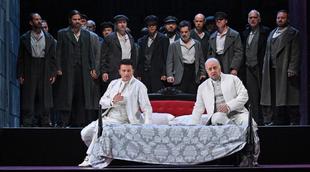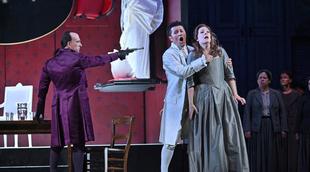 Piotr Beczala i Sondra Radvanovsky (© A. Bofill)
Piotr Beczala i Sondra Radvanovsky (© A. Bofill)
Once again, the season at Liceu comes to a close and, very importantly, Christina Scheppelmann’s era as artistic director of the Barcelonan theatre ends as well. She will be the new artistic director at the Seattle Opera from August. Having been leading Liceu for the last five years and having had to face grave economic limitations, she has nevertheless left important landmarks for Liceu’s artistic history such as Benvenuto Cellini, the celebrated Andrea Chénier with Kaufmann, Radvanovsky and Carlos Alvarez or Kàtia Kabànova. From next season, Liceu’s artistic director will be Víctor Garcia de Gomar, who until now was artistic director at Palau de la Música.
Luisa Miller was the title chosen for the farewell of the season, a relatively minor piece in the operatic repertoire. This is neither an early Verdi nor quite yet a mature title of his, making it an awkward opera which announces unequivocally the great Verdi but musically doesn’t belong to the select group of the composer’s best works. It illustrates perfectly an advanced stage, although still intermediate, within the long process that brought Verdi from the musical language inherited from the late bel canto to the configuration of his own personal language, which will flourish in the ‘popular trilogy’ formed by Rigoletto, Il Trovatore and La Traviata, which follows immediately after Luisa Miller.
Based on Schiller’s drama Kabale und Liebe, Luisa Miller inherits the theatrical force of the German dramatist’s characters but in its operatic transformation loses – due to the oppressive censorship received by Verdi and his librettist Salvatore Cammarano – the social critique dimension of the original text.
Despite its musical ‘imperfection’, Luisa Miller presents great vocal demands in the main roles of Luisa and Rodolfo, which require generous voices. The demands of the score are also great on the relatively secondary characters.
In the protagonist couple, we thankfully had two exceptional performers who are at the best point in their careers: North American soprano Sondra Radvanovsky and Polish tenor Piotr Beczala. It feels very difficult to say who of the two did better, as they were both at a very high level and it seems difficult to imagine better current singers for the roles. In both cases, a great control of the breathing, beauty in the timbre, clean and brave attacks in the upper register as well as delicate pianissimi in the higher notes and capacity to scenically embody the characters through gesture and singing were the main characteristics of the performers. He had an advantage point to triumph, as “Quando le sere al placido” is one of the most beautiful tenor arias Verdi ever produced, and Beczala took the opportunity. She, however, took advantage of her less well known “Preghiera” in the last act in order to weave sublime pianissimi that resembled those of Caballé.
Perfectly right but at a lesser level to that of the main couple were baritone Michael Chioldi in the role of Miller and bass Dmitry Belosselskiy as Count Walter. Only sufficient were bass Marco Mimica, who didn’t make the most of the vocal possibilities of Wurm’s character, as well as J'Nai Bridges in the minor role of Federica.
Venezuelan maestro Domingo Hindoyan, debuting at Liceu, yet another fruit from the educational project ‘El Sistema’ – which has Gustavo Dudamel as its most famous representative – obtained a good response form the orchestra and the choir and brought well together the orchestra with the voices. He would have enjoyed a greater success had Radvanovsky and Beczala not outshined in the applause.
The production, coming from Zürich’s Opernhaus, was signed by Damiano Michieletto as stage director. The presence of two dominant fathers – Miller and Walter – and two children who oppose them – Luisa and Rodolfo – suggested to Michieletto the idea of symmetry and of a mirrors’ interplay. Translated to the stage, the idea materialises in a duplicate of tables, beds and chairs to show that the relationships of the fathers with their children are two sides of the same coin. The idea is ambitious but visually doesn’t quite work as it becomes heavy. Theatrically it works even less and overly conditions the flow of the already complicated plot. Moreover, despite the ambition of the project, the dramatic treatment of the characters remains totally conventional and that of the choir is reduced to a grey, anonymous, static and inexistent crowd. It is not a bad production of Luisa Miller but it will not go down in history nor leave a perdurable trace in the memory.
Xavier Pujol
(14th July 2019, Barcelona)



Comments